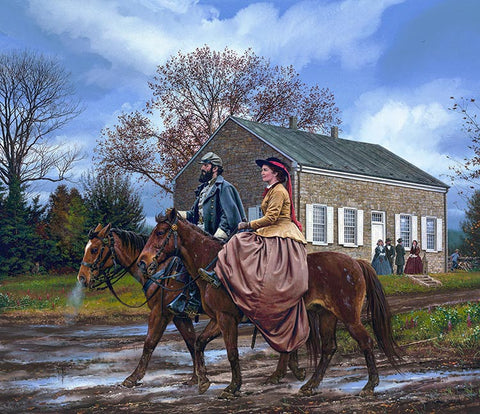Goose Creek Bridge
by John Paul Strain
General JEB Stuart, Near Middleburg, VA - June 21, 1863
General Robert E. Lee began what would become known as the Gettysburg campaign in the early days of June 1863. He carefully marched the Army of Northern Virginia across the Blue Ridge Mountains and into the Shenandoah Valley. Detection by the enemy was one of General Lee’s main concerns. He gave his Cavalry Commander Major General JEB Stuart, the assignment of screening the army’s movements by operating on the eastern side of the Blue Ridge Mountains. General Stuart would need to keep Federal Cavalry from discovering the Army of Northern Virginia heading north into Maryland and on into Pennsylvania.
At the same time, US Major General Joseph Hooker gave orders to his Cavalry Commander Brigadier General Alfred Pleasonton. “The commanding general relies upon you…to give him information of where the enemy is, his force, and his movements…It is better that we should lose men than to be without knowledge of the enemy, as we now seem to be.”
The opposing cavalry forces found each other on June 17th, and the running battles from Aldie, Middleburg, and Upperville lasted through the 21st.
Cavalry charges and counter charges were frequent. Engagements were fast and ferocious. General Stuart directed most of the fighting, employing lightning tactical charges and then giving ground to delay the larger federal force’s advance. This bought valuable time needed for General Lee’s army to march without being discovered.
On June 21st, the Goose Creek bridge, located between the towns of Middleburg and Upperville on the Ashby Gap Turnpike, became a choke point that was a focus of the opposing forces. The four-arched stone bridge spanning that waterway was a perfect location for General Stuart to slow the Federal advance. Facing 7000 Cavalry and infantry troops, Stuart, with the help of General Wade Hampton, strategically placed cannon on the west side of the bridge holding off the federals for two hours until they in turn brought up their own cannon. A devastating artillery duel ensued until the Confederates retired to the next high ground to the west. General Stuart’s stand at the bridge gave him time to consolidate his force east of Upperville, where he again delayed the Federal advance.
General Stuart’s skill succeeded in preventing General Pleasonton’s men from discovering the Army of Northern Virginia’s invasion north across the Potomac River. The battle of Gettysburg would begin just 10 days after the clash at Goose Creek. General Stuart’s next challenge would be to somehow get around the Federal forces and join General Lee somewhere to the north.
Archival Paper Giclées:
200 S/N Paper Giclées
50 Artist's Proof Paper Giclées
Image Size: 19 1/4" x 27 1/2"
Canvas Giclées:
100 S/N Studio Canvas Giclées
15 Artist's Proof Studio Canvas Giclées
Image Size 17" x 24 1/2"
100 S/N Classic Canvas Giclées
15 Artist's Proof Classic Canvas Giclées
Image Size 23" x 33"
30 S/N Executive Canvas Giclées
5 Artist's Proof Executive Canvas Giclées
Image Size 27 3/4" x 40"






Share this item: